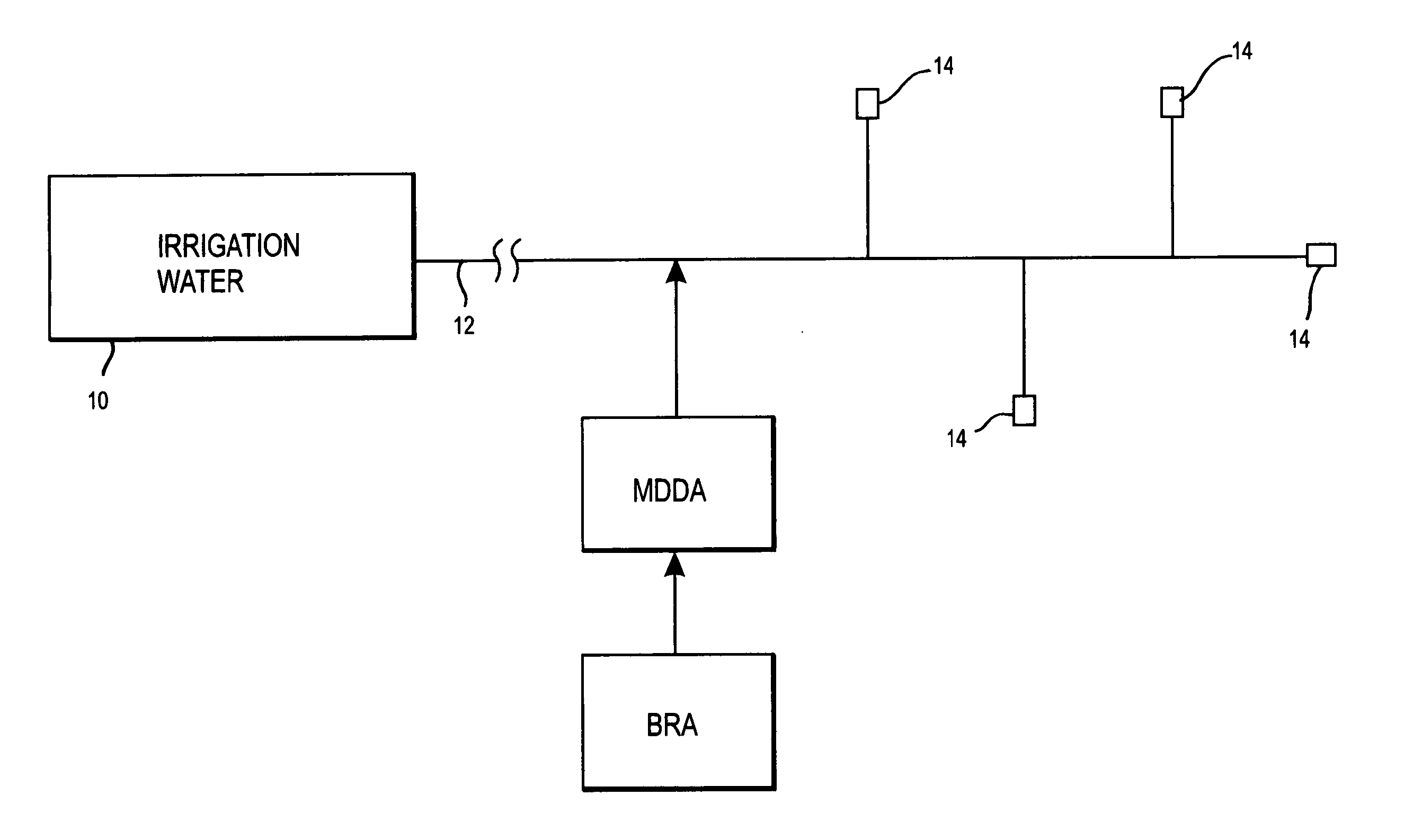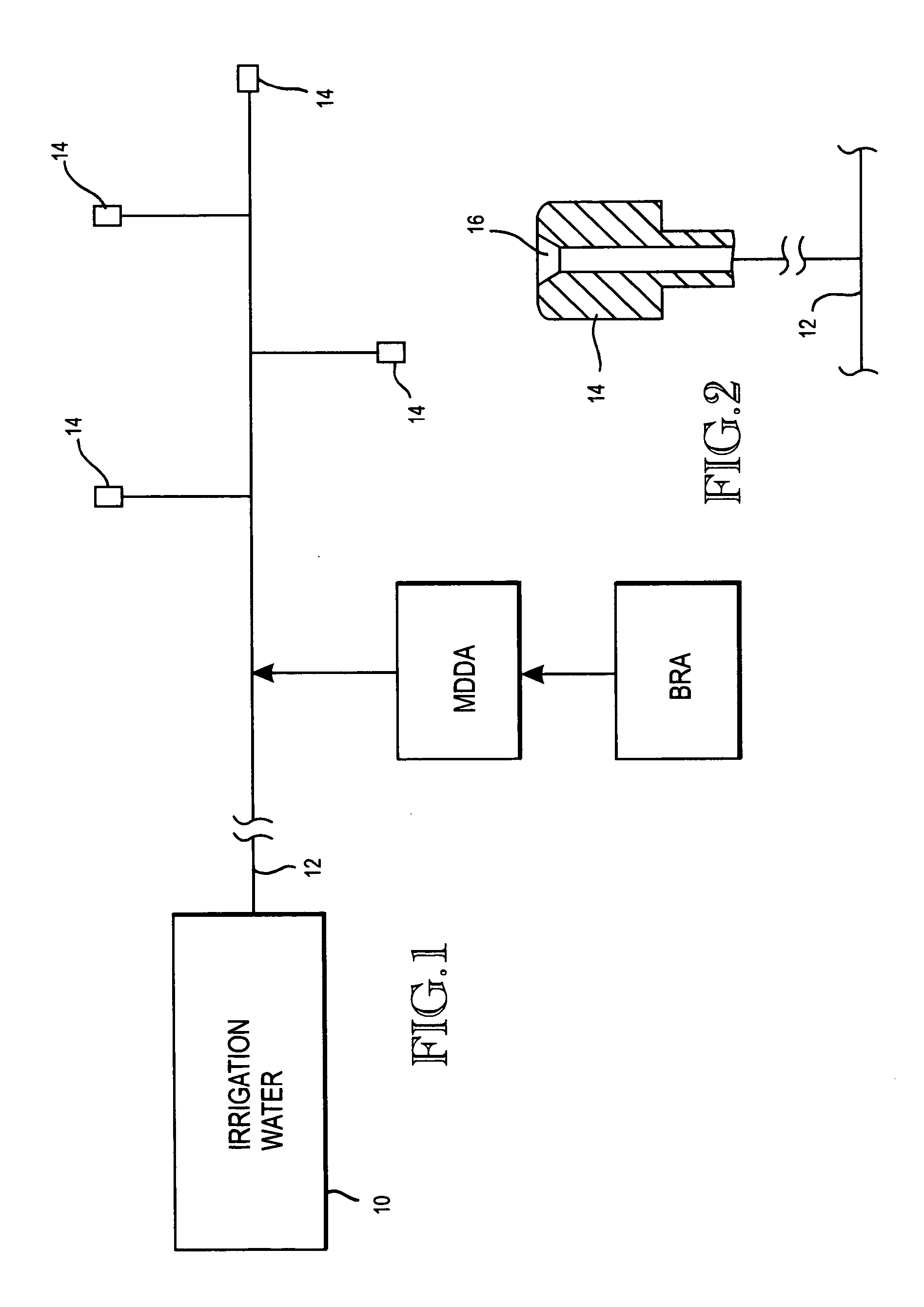Method of promoting unrestricted flow of irrigation water through irrigation networks
a technology of irrigation network and flow rate, which is applied in the direction of water/sewage treatment by oxidation, non-contaminated water treatment, complex/solubilising chemical treatment, etc., can solve the problems of loss of flow rate through irrigation network, damage to plants, and precipitation out, so as to preserve unrestricted flow of irrigation water, eliminate biofilm formation, and eliminate the effect of biofilm formation
- Summary
- Abstract
- Description
- Claims
- Application Information
AI Technical Summary
Benefits of technology
Problems solved by technology
Method used
Image
Examples
example 1
[0017] Water (27.5%), phosphonobutanetricarboxylic acid (17.5%) and hydrochloric acid (55%) were mixed together in a solution. Water (85%) and sodium chlorite (15%) were mixed together to form a second solution. Sufficient contact time was allowed in a container to convert a substantial portion of the sodium chlorite into chlorine dioxide. The feed of the two solutions to the third container was 1500 milliliters per hour of each solution was introduced into a container. The reacted solution from the container was introduced into a 300 gpm flowing water irrigation network that included emitters through which the irrigation water was discharged. This irrigation water mixture was used by a greenhouse grower to irrigate plants in greenhouses. The grower saved a significant amount of money by substantially eliminating plant loss, maintenance costs to clean the emitters, filters and the cost of replacing the emitters. The mixture flowing through the emitters contained substantially 3.0 pp...
example 2
[0018] A hothouse grower of tomatoes and cucumbers prepared a first solution of water (27%), hydroxyethylidene disphosphinic acid (18%), and hydrochloric acid (55%) in a first container. Water (85%) and sodium chlorite (15%) were mixed in a second container to form a second solution. The two solutions were mixed together in a container to form a food-grade composition. This composition was introduced into an irrigation network in which water flow was 760 gpm. The two chemical solutions were fed into the container at the rate of 1800 milliliters per hour. The reacted mixture was introduced into flowing irrigation water in an irrigation network. The mixture of the solutions in the container yielded approximately 0.5 ppm chlorine dioxide, approximately 1.0 ppm mixed oxidants, and approximately 1.0 ppm phosphonate. Water flow rates through the emitters increased from about 2400 liters per minute to about 3000 liters per minute within a five-week period of time. The treatment eliminated ...
example 3
[0019] A hothouse grower growing certified organic food crops (tomatoes), admixed a solution of 80% water, 15% citric acid and 5% of acetic acid and another solution of 85% water and 15% sodium chlorite into a container. Approximately 65 ounces of the citric acid, acetic acid and water solution and 30 ounces of the sodium chlorite and water solution were introduced into the container per hour. This solution comprised of certified organic components was introduced into 130 gpm flowing irrigation water to yield 1.75 ppm chlorine dioxide and 3.5 ppm mixed oxidants. Higher feed rates of the citric acid, acetic acid and water compound were fed to distort the source water minerals and iron based fertilizers so amorphous deposits would be formed, that are easily washed through to the irrigation emitters preventing plugging. After four weeks of treatment the pre-filters and emitters were clear of biofilms, mineral and fertilizer build up. Prior to treatment this grower experienced severe pl...
PUM
 Login to View More
Login to View More Abstract
Description
Claims
Application Information
 Login to View More
Login to View More - R&D
- Intellectual Property
- Life Sciences
- Materials
- Tech Scout
- Unparalleled Data Quality
- Higher Quality Content
- 60% Fewer Hallucinations
Browse by: Latest US Patents, China's latest patents, Technical Efficacy Thesaurus, Application Domain, Technology Topic, Popular Technical Reports.
© 2025 PatSnap. All rights reserved.Legal|Privacy policy|Modern Slavery Act Transparency Statement|Sitemap|About US| Contact US: help@patsnap.com


